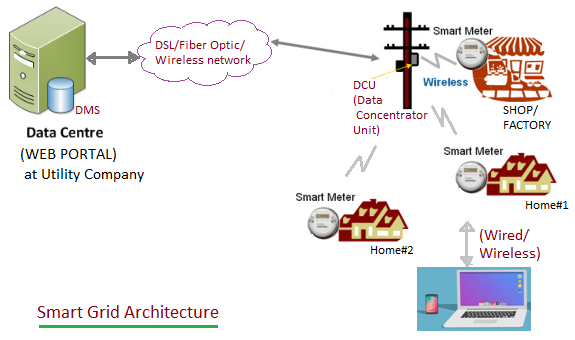Smart Grid system
What is Smart Grid?
Introduction:
• An electricity distribution network which uses digital communication means to detect local changes in usage of power and react automatically without any human interactions is known as smart grid.
• It uses smart meters and appliances, renewable and efficient energy resources.
• The system delivers electricity via 2-way digital communication. It allows consumers to interact with the grid.
• The smart grid overcomes many drawbacks of traditional electrical grids and provides benefits to consumers, electricity company and government establishments.
• It reduces energy consumption and reduces cost to the consumers by smart means. Electric supply companies make efficient usage of energy and consecutively will be able to meet the varying load demands of the consumers.
Generic Smart Grid Architecture Components

The figure-1 depicts generic Smart Grid Network Architecture components or modules with different reference points. As shown typical smart grid network consists of following components.
• Grid domain (Operations include bulk generation, distribution, transmission)
• Smart meters
• Consumer domain (HAN (Home Area Network) consists of smart appliances and more)
• Communication network (Connects smart meters with consumers and electricity company for energy monitoring and control operations, include various wireless technologies such as zigbee, wifi, HomePlug, cellular (GSM, GPRS, 3G, 4G-LTE) etc.
• Third party Service providers (system vendors, operators, web companies etc.)
Smart Grid Architecture Working for smart metering application

• The above photo depicts Smart Grid Architecture for smart metering application used by electricity company.
• As shown smart meters are installed at home, office and factory premises. These smart meters communicate with DCU (Data Concentrator Unit) located on the electric pole near the residential layout. Meters can provide parameters which include instantaneous consumptions, cumulative energy, time of day energy data, Maximum Demand (KW) etc.
• The Data concentrator units installed in the area collects the energy usage and other parameters related to status of meters. These collected information is transmitted to the data servers located at utility company or at third party premise using wired or wireless means. The transport mechanism can be DSL, Fiber optic or wireless network (2G, GPRS, 3G, 4G-LTE etc.).
• The complete smart grid network information can be updated/monitored by web site or web portal using laptop/mobile/tablet/PC. Web portal communicates with DCUs in real time for data collection and data processing. It reports tampering of meters, billing information, energy usage, load status etc.
Refer advantages and disadvantages of smart grid system.
Other IoT articles
IoT based Systems
Smart lighting architectureZigbee smart parking architecture
LoRaWan Smart Parking Architecture
Aircraft Lavatory Cleanliness Monitoring
Smart Water Quality Monitoring
Go to the PCB knowledge Page
Go to the PCB design resources page
Back to the technology data
PCB Blog
Contact Us
E-mail: [email protected]
E-mail: [email protected]
Skype: [email protected]
Whatsapp: +86 15012972502
Add: 2F, BUILDING H, WANDA INDUSTRIAL ZONE, ZHOUSHI ROAD, LANGXIN COMMUNITY,SHIYAN STREET, BAO 'AN DISTRICT, SHENZHEN, GUANGDONG, CHINA







 Skype Chat
Skype Chat WhatsApp
WhatsApp  Mail inquiry
Mail inquiry